|
Introduction
- Insect pests cause severe losses to groundnut
and are recognized as one of the major constraints
in groundnut production. Although more than 90
species of insect pests attack groundnut crop,
only a few are economically important over large
areas.
- Pests are dynamic and their status change rapidly.
Due to rapid increase in the area under groundnut
cultivation, particularly under irrigated conditions
with improved methods of cultivation, insects
such as gram caterpillar, tobacco caterpillar,
jassids and mites, which were minor pests in the
past have now become important in certain areas.
- For the effective control of insect pests, bionomics
of pests needs to be investigated not only on
groundnut crop but also on several other crops
because many pests of groundnut are polyphagous
and their abundance on groundnut may well depend
upon the alternate crop hosts.
- High cost of pesticides and appliances and large
quantities of water required for spray applications
are the major limitations on pesticide use by
subsistence farmers especially under rainfed conditions.
- Other means of control such as cultural practices,
mixed or intercropping, biological control and
host plant resistance will be useful to develop
an integrated pest management.
 Top
Top
Earwig
(Pod borer)
|
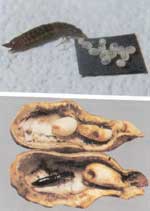
|
- Earwigs [Anisolabis annulipes (Luc.)] bore into
the tender pods and feed on kernels. The holes are
plugged with excreta, sand particles and discoloured
pulp.
- It is difficult to separate out damage caused
by earwig from that caused by wire-worms and termites
and more often the damage by these insects is attributed
to earwig-pest.
- The semi-spreading and spreading varieties are
found more susceptible than the bunch varieties
|
Biology
- Earwigs generally feed on vegetable matter.The females
lay eggs 10 - 23 days after pairing. The pearly white
eggs are laid in clusters,which hatch in 7-11 days. Nymphs
pass through 5 instars and adults live up to 252 days.
- Cabbage, cotton bolls and sorghum stems are found infested
with them.
Management
- Apply @ 25 kg /ha either malathion 5% dust or endosulfan
4% D to soil prior to sowing in areas where the earwig
is endemic. Repeat soil application of any one of the
above formulations on 40-45 DAS and incorporate in the
soil during the earthing up operation.
 Top
Top
Gram caterpillar
|
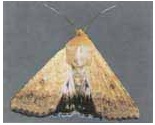
|
- Gram caterpillar or boll worm (Helicoverpa
armigera (Hubner) is a major pest of cotton
and vegetables and it causes moderate damage to
the groundnut crop in recent years. This species
is widely distributed throughout India.
|
Stage and symptoms
|

|
- The damage caused by the larvae to foliage is
similar to that caused by the tobacco and hairy
caterpillars but it prefers to feed on flowers and
buds. Young larvae enter leaf bud by making a pin-hole.
These pin-holes form mirror images on the expanded
leaf.
|
- The larvae feed on flowers by preference and also on
foliage, when full grown, they leave the plant, burrow
into the soil to a depth of 2-18 cm and pupate. Severe
infestation leads to complete defoliation leaving only
the stems and branches in the field.
Biology
- This pest completes 4 generations in a year. Moths emerge
from pupae in the evening hours and not during daytime.
The peak mating activity is at early morning. The fecundity
usually high ranging from 480 to 1600 eggs with a mean
of 730 eggs/female. * Eggs are yellowish-white, dome-shaped
and have longitudinal ribs. The eggs are laid in leaf
buds of groundnut and hatch in 2-5 days.
- Larvae after passing through 6 instars become full-grown
and are 35-42 mm long, pale-green in colour and have one
distinct longitudinal stripe on each side and one line
on the dorsal side. The colour of larval body is usually
variable and they pupate in soil.
- The pupae are 14-18 mm long and smooth surfaced. Pupal
period is 5-8 days. * Adult is a stout bodied moth, 18-19m
m long with a wing expanse of 40 mm. Fore-wings are pale-brown
with a series of marginal dots, black kidney-shaped mark
present on the underside of fore-wings.
- Combined incidence of both Helicoverpa and Spodoptera
is observed in all the seasons in certain pockets particularly
in Cuddalore and Villupuram districts. The incidence is
further aggrevated when groundnut was intercropped with
cotton.
- This has been reported in as many as 96 crop plants
and 61 weed species. However, the crops like pigeonpea,
field-bean, chickpea, tomato and cotton are preferred
hosts.
ETL
- Ten per cent leaf damage is considered as economic threshold
level.
Management
- Grow sunflower as border or intercrop in groundnut fields
to serve as indicator or trap crop for Helicoverpa.
- Destroy weed host, Gynandropsis pentaphylla, which serves
as alternative hosts for the Helicoverpa to lay its eggs.
- Monitor the emergence of adult moths by setting up light
trap or pheromone traps (5 per ac).
- Avoid monocropping
- Optimising the use of nitrogenous fertilizers which
will not favour the multiplication of pest.
- Avoid migration of larvae by digging a trench 30 cm
deep and 25 cm wide with perpendicular sides around the
infested fields.
- Prepare bait with the following materials to cover one
hectare. Rice bran 12.5 kg, molasses or brown sugar 2.5
kg and carbaryl 50 WP 1.25 kg. Mix the ingredients to
obtain a homogeneous mixture, sprinkle water gradually
and bring the bait to a dough consistency. Distribute
the above bait on the soil, around the field and inside
in the evening hours immediately after preparation.
- Application of nuclear polyhedrosis virus (NPV) @ 250
LE/ha with crude sugar 2.5 kg/ha in the evening hours
is as effective as that of insecticide spray.
- Crop rotation with sorghum, maize, cumbu and sugarcane
may be tried to minimize the infestation.
- Release Trichogramma egg parasitoids @ 7.5 cc/ha.
Release of Chrysopha predators @ 2500/ha to control young
larvae.
- Apply any one of the following insecticides to control
early instar (Ist to 3rd instar) larvae.
Carbaryl 10 D- 25 kg/ha;
Carbaryl 50WP - 2.0 kg/ha;
Quinalphos 20 EC- 750 ml/ha;
Dichlorvos 76 WSC – 750 ml/ha;
Endosulfan 35 EC - 1.0 lit/ha.
- Spray any one of the following insecticides per ha to
control 4th to 6th instar larvae.
Chlorpyriphos 20 EC - 2.0 lit;
Dichlorovos 76 WSC 1.0 lit;
Phenthoate 50 EC - 2.0 lit.
R- Rainfed; I- Irrigated
 Top
Top
Leaf miner
Introduction
- Leaf miner (Aproaerema modicella Deventer) was
endemic to south India but now it appears to be pest of
economic importance in Maharastra and Gujarat also.
Stage and symptoms
- Initially, small blister-like mines are seen on the
upper surface of leaf near the midrib. As the feeding
advances, mines increase in size and the entire leaflet
becomes brown and it rolls, shrivels and dries up. Severely
infected plants may die and the affected crop gives a
burnt appearance.
Biology
- The adult lays white, shiny and beautiful sculptured
0.5-0.8 mm long eggs singly on groundnut leaflets and
shoots. The eggs hatch in 2-3 days.
- The young caterpillar is creamy-yellow with a dark-brown
head. The caterpillars mine the leaflets near the midribs
and proceed towards the margins by feeding on the green
tissues in between the epidermal layers.
- After a week, the caterpillars emerge from the mines,
fold a leaflet or web together two or more leaflets and
continue to feed on the green tissues.
- The caterpillars moult thrice. The larval period lasts
for 9-17 days. The caterpillars grow to about 6-8 mm long
and are moderately stout, pale-greenish or brownish with
a black head and prothoracic shield. The cuticle is smooth
except for a few scattered short bristly - hairs which
arise from minute blackish chitinous warts.
- The pupal period varies from 3-7 days. Moths are small,
8-10 mm in length and greyish. The adults live for 5-20
days. The total life cycle from egg to adult is completed
in 15-28 days.
- The insect completes 3-6 generations during the rainy
season and 3-4 generations in the post rainy season.
- The insect is capable of breeding throughout the year.
The rainfed crops suffer more in July to August and the
irrigated crop during February to May.
- Dry weather, bright sunshine and occasional rains encourage
population build up whereas heavy and persistent rains
and high humidity reduce the population of this insect.
- This pest has a restricted host range of legumes. Groundnut
and soybean are principal crop hosts.
ETL
- The chemical control measures may be taken when the
pest crosses economic threshold level of 1 larva per 1
meter row.
Management
- Early sowing (before 15th of July) in rainfed groundnut
reduces the incidence.
- Use light traps for monitoring the pest incidence.
- Setting up of pheromone traps.
- Weed free crop reduces leaf miner incidence.
- Leaf miner prefers soybean for its early occurrence.
This can be watched on soybean and first generation larvae
can be collected and destroyed.
- Grow pearlmillet or lablab as an intercrop in groundnut
(1:4 ratio)
- Mulching with a straw of pearlmillet or other crops
in dry lands helps to reduce leaf miner incidence.
Regulate irrigation in the growth period so as to avoid
drought stress, which increases pest incidence (or) spray
water one or two times, which will minimises the pest
population.
- Spray neem seed kernel extract (15 kg/ha) or neem oil
(15 lit/ha) or neem leaf extract (25 kg/ha).
- Spray any one of the following insecticides
Monocrotophos 36 WSC - 750 ml/ha;
Dichlorvos 76 WSC - 625 ml/ha;
Phosalone 4% Dust – 25 kg/ha ;
Endosulfan4% Dust – 25 kg/ha
 Top
Top
Red hairy
caterpillar
Introduction
|
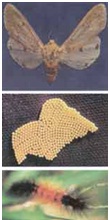
|
- Among the several species of hairy caterpillars,
Amsacta albistriga Walk. is found in southern
India and A. moori Butler, in the northern states.
- The attack of A. albistriga is now sporadic
in some areas; in certain years it can become
serious and cause heavy losses. Reappearance of
the pest was noticed recently after a long gap
in Cuddalore and Villupuram districts of Tamil
Nadu.
|
Stage and symptoms
|
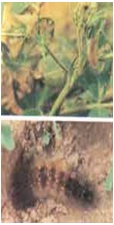
|
- Young larvae feed gregariously on the under
surface of the leaves by scraping them. This feeding
continues for 4-5 days and the dried scraped-patch
of the leaves can be easily detected.
- As larvae grow they disperse and feed individually
by devouring leaves, flowers and growing points.
When a large number of caterpillars infest the
crop, only the base stems of the plants remain
resulting in heavy and occasionally a total yield
loss.
|
Biology
- Moths emerge from pupae present in the soil after the
onset of heavy rains, usually after the second day of
such rains. The eggs are laid in clusters and each cluster
contains over 40 eggs and occasionally up to 880 cream
coloured eggs.
- The eggs are laid on the available host plants, hedges,
weeds or even clods of earth. After 3-4 days, small larvae
come out and feed gregariously.
- When the crop emerges larvae move enmasse on to them.
The grown up larvae feed individually and are ash-brown
in colour. The full-grown larvae after 20-31 days assume
reddish colour. Their hairiness makes them conspicuous
especially the larger ones are up to 5 cm long.
- Pupation takes place in soil at a depth of 10-20 cm
under trees, hedges, shady places or bunds. The pupae
remain in soil in diapause stage till the next monsoon.
- There is only one generation in a year. The mass emergence
of moths is well synchronized with rains, occurring in
June-July in Vellore, Salem districts, in May in Pollachi
region and in August to October in Madurai and Ramanathapuram
areas.
- It is a polyphagous insect, the other host species are
ragi, cowpea, castor, sorghum, cotton, pearlmillet, maize,
soybean, horsegram, blackgram, greengram, cluster bean,
pigeonpea, sesame, jute, sunnhemp and several other weeds.
ETL
- The ETL for the pest is fixed as 8 egg masses/100 m
of crop length or 10% leaf damage.
Management
- Deep summer ploughing helps to destroy the pupae in
the soil.
- Set up 3 to 4 light traps immediately after receipt
of rains, after sowing in the rainfed season to attract
and kill the moths and also to know the brood emergence.
- Burning of trashes between 10.00 p.m. to 1.00 a.m. a
day immediately after the monsoon showers found to attract
large number of RHC moths and got killed in the fine.
Collect and destroy the egg masses.
- Collect gregarious, early instar larvae on lace-like
leaves of groundnut and in intercrops such as redgram
and cowpea. Cowpea serves as an indicator crop for early
monitoring of red hairy caterpillar.
- Leaves of Calotropis can be placed in fields to attract
the larvae and destroy them. These larvae are immersed
in cow dung slurry for killing (5 kg of cow dung dissolved
in 20 lit of water).
- Formation of trenches 45 x 15 cm all round the field
and filling them with Calotropis leaves found to trap
the migratory larvae in large numbers and they can be
killed either by using insecticides or fire or by crushing.
- Collect pupae of Amsacta from field bunds and shady
places and destroy them on receipt of summer showers.
- Grow cowpea or lablab in groundnut as intercrop (4:1
ratio)
Spray NPV of Amsacta @ 250 LE/ha after mixing it with 2.5
kg of jaggery.
- Grow castor, redgram and cowpea as trap crop to attract
the moths for laying eggs. These egg masses are to be
collected and destroyed.
- Place poisoned food in the field as in the control of
Spodoptera.
- Any one of the following insecticides can be applied
to control early instar larvae.
Dichlorvos 76 WSC - 625 ml/ha;
Quinalphos 25 EC - 750 ml/ha;
Fenitrothion 50 EC - 750 ml/ha;
Chlorpyriphos 20 EC - 1250 ml/ha.
- For the control of late instar larvae, spraying of insecticides
will not be effective. Instead, mechanical control, NPV
spray, poisoned food, etc. may be tried to manage the
pest.
 Top
Top
Sucking Pests
Groundnut jassid /Leaf hopper
Introduction
- Among the various species of jassids that infest groundnut,
Empoasca kerri Pruthi is the dominant species.
This insect was a minor pest in the past, but has become
a major pest in recent years. The incidence is noticed
in almost all the seasons.
Stage and symptoms
|
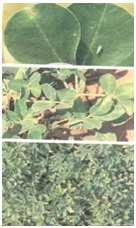
|
- Both adults and nymphs suck sap from young leaves
mainly from the under surface. The initial injury
to groundnut appears on young leaves, veins become
white. The affected leaves of young plant wilt
and in older plants wilting is rare.
- In severe cases of infestation a `V' shaped
yellowing on the tips of the leaflets is observed,
which may spread and the entire leaflet may become
yellow.
- Groundnut when infested with jassids look yellow
compared with unaffected crops.
|
Biology
- The groundnut jassid is a yellowish-green insect measuring
about 3 mm in length. Males are slightly smaller and greener
than females.
- The eggs are inserted into the leaf tissue mainly near
the midrib and veins from the under surface of the leaves.
They are broad and rounded at one end and gradually taper
towards the other end. The egg period is 7-10 days and
the nymphal period is 7-14 days.
- The jassid infestation is negligible during the hot
summer months from April to June. It increases gradually
from the first week of July to reach a maximum in early
September. From October to April, the population remained
at a low level except for a slight increase during the
early part of December. The population was much smaller
in winter than in rainy season.
- This pest has also been reported on castor, clusterbean,
maize, soybean, greengram, blackgram, cowpea and pigeonpea.
Crop loss
A loss of 9% in pod yield and 18% in haulm weight was attributed
to jassids.
ETL
Spraying of insecticides is to be taken up if more than
10 % of the leaves have the characteristic "hopper
burn" symptoms.
Management
- Intercropping of groundnut with lablab (4:1 ratio) generally
reduces the number of jassids on groundnut.
- High degree in resistance to jassids is observed in
groundnut genotypes with hairy leaves. Higher densities
of hairs hinder feeding of young nymphs. In addition to
hairyness, the resistant genotypes had thick leaves.
- Among the wild species, A.glabrata, A.macedoi, A.villosa,
A.stenosperma and A.batizocoi are found to be highly resistant
to jassids.
- Spraying any one of the following systemic insecticides
controls the pest population.
Monocrotophos 36 WSC - 750 ml/ha;
Phosphamidon 85 WSC – 375 ml/ha;
Dimethoate – 1000 ml/ha.
Groundnut aphid
- Aphis craccivora Koch. is a sporadic pest of
groundnut in India.
Stage and symptoms
- Both adults and nymphs feed mostly on growing tips and
young foliage by sucking the sap. Under heavy infestation,
the plant becomes chlorotic and leaves curl. It also infests
flowers and pegs.
Biology
- The nymphs of aphids pass through 4 moults before becoming
adult and the duration of each instar is usually 1-2 days.
- The aphids remain active throughout the year and peak
incidence occur during drought periods. The infestation
by the aphids is relatively higher in rabi compared to
kharif crop.
- Several crop plants like redgram, bengalgram, soybean,
lucerne, blackgram, greengram, peas, sesbania and several
weeds have been reported as hosts to this pest.
Crop loss
- It is estimated that this pest alone can reduce yield
by about 40%.
Management
- Parasites and predators especially coccinellids reduce
the population of aphids considerably.
- If the terminal buds are infested in the young crop,
spray dimethoate @ 1 lit/ ha on 30 DAS. Release of aphid
lion, Chrysoperla carnea grubs @ 5000/ha.
Management strategies for sucking pests
- Yellow sticky traps can be placed at random in 25 to
30 places/ha to attract the pests.
- Intercropping of cowpea in groundnut attracts the sucking
pests.
- Planting of maize as border crop, helps for the multiplication
of predator, coccinellids.
- Release of Chrysopha @ 2500/ha reduces the population
of sucking pests in the groundnut field.
- Spraying of neem seed kernel extract (3%) controls the
pest incidence. (Soak 15 kg of dried and powdered neem
seed kernels in 15 lit of water overnight. This is filtered
through muslin cloth and the supernatant is made up to
500 lit of spray fluid. This spray fluid is used for spraying
one hectare).
- Release of coccinellid beetles @ 2500/ha.
- Release of egg parasitoid, Trichogramma @ 7.5 cc/ha.
- Spray any one of the following chemicals.
Monocrotophos 36 WSC - 750 ml/ha;
Dichlorvos 76 WSC -625 ml/ha;
Phosphamidon 85 WSC - 375 ml/ha
 Top
Top
Thrips
Introduction
- Several species of thrips infest groundnut, the major
pests being Scirtothrips dorsalis Hood, Caliothrips
indicus (Bagnall) and Frankliniella schultzei
(Trybom).
Scirtothrips dorsalis
- This species is well distributed throughout India. The
losses depend upon the degree of infestation, age of the
crop, variety and weather conditions.
Stage and symptoms
|
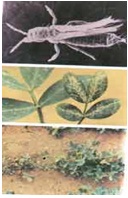
|
- The nymphs and adults of the species feed on
the terminal portion of groundnut plant mainly
inhabiting the unopened leaves. They scrap the
leaf surface and suck the oozing sap.
- The injury results in the development of dull
yellowish-green patches on the upper surface and
brown necrotic areas on the lower side. Under
heavy infestation the young leaves curl. The prolonged
and heavy infestation may result in stunting of
plants.
- Usually bunch varieties, larger canopy and yellowish-green
foliage are highly affected. Dwarf and sickly
plants are less attractive.
|
Biology
- Adults are less than 0.75 mm long and yellowish. When
at rest, the wings are folded over the abdomen and form
a dark line with five transverse dark-brown thin bands
on the dorsum of abdomen. The wings are slender and forewings
have a few setae.
- Thrips lay eggs inside the leaf tissue, entering from
the lower surface. The eggs are small, kidney shaped,
0.075 mm long and 0.030 mm broad. They hatch in 6-9 days.
The nymphs pass through 2 larval instars of 2-3 days each,
and complete pre-pupal stage and pupal instars in 2-3
days. Pupation occurs on plant at sheltered places such
as spider webs, leaf mines and webbed leaves.
- Mating takes place soon after the adults emerge from
pupae. An individual female lays about 30-40 eggs in a
life span of 15-23 days.
- These thrips are active throughout the year. Their population
is highest from July to September and February to March.
- The crops like drumstick, grapevine, tea, acacia, cashew,
citrus, jamun, tamarind, greengram, blackgram, chillies,
soybean, tomato, pea, potato, sunhemp, horsegram, mango,
sunflower, cotton and several weeds and ornamental plants
have been reported as hosts for S.dorsalis.
Crop loss
- An estimated loss of 17% in pod yield and 30% in haulm
yield was observed due to this species.
Caliothrips indicus
Introduction
- This species is distributed throughout India and is
a serious problem particularly during dry weather.
Stage and symptoms
- The thrips feed on the upper surface of groundnut leaves.
The lower leaves of the plants are the preferred feeding
sites. The injury results in small white spots and patches
on the leaf surface intermingled with black excreta.
- Under dry conditions and heavy infestations, the leaves
become dry and plants become stunted. The thrips are easily
washed away by rains because they inhabit the upper leaf
surface and are rarely a pest in higher rainfall periods.
Biology
- On groundnut, eggs are inserted inside the leaf tisue
from the upper surface, which hatch in 7-10 days.
- The first larval instar completes in 2-4 days and the
second in 3-5 days and pre-pupal and pupal instar complete
in 3-5 days.
- Population of this insect on groundnut are highest in
June and July and the breeding continues in August and
September if dry weather prevails. Another peak activity
occurs during March and April. Very low populations occur
from December to February.
- Potato, cabbage, cauliflower, knolkhol, chillies, brinjal,
onion, wheat, cotton, pea, linseed, fennel, sunnhemp,
daincha, blackgram, greengram, sorghum, pigeonpea, bengalgram,
tomato and lucerne are reported as host plants.
Frankliniella schultzei
Stages and symptoms
- The adults and nymphs feed on young leaves and buds
of groundnut causing scars on the upper surface. The insects
mostly inhabit the young leaves and flowers, the nymphs
prefer leaf buds.
- This species is more harmful as a vector of tomato spotted
wilt virus that causes diseases of economic importance
in several crops including groundnut.
Biology
- The adults are yellowish-white, 0.9-1.0 mm long. The
fore- wings bear 2 rows of continuous setae and 3 pairs
of long setae on the second and third segments of the
vortex of the thorax. The females insert eggs inside the
leaf tissue.
- The eggs hatch in 6-8 days. First larval instar completed
in 2-4 days and the second in 3-4 days. The pre-pupal
stage completes in 1-2 days and the pupal instar lasts
for 2-5 days.
- The thrips disperse throughout the year mainly by prevailing
winds. The population was less in March to June and generally
increased to reach peak in late August and September,
when most crop plants got infested. The population declined
during October and November and picked up again in January
and February.
- Several crops, weeds and ornamental plants are inhabited
by this insect. Among crop plants, groundnut, sunflower,
tomato, potato, beans, peas, greengram, blackgram and
other legumes are major hosts.
ETL
- Five thrips per terminal leaf up to 30 DAS.
Management
- Early (first fortnight of June) sowing had the lowest
thrips damage than late (July) sowing.
- Spray dimethoate @ 1 lit/ha if more than 5 thrips per
terminal leaf only up to 30 DAS.
- Grow resistant varieties like Robut 33-1, Kadiri in
endemic areas.
 Top
Top
Tobacco
caterpillar
Introduction
|
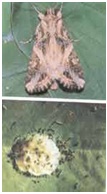
|
- The tobacco caterpillar [Spodoptera litura
(Fab.)] also known as army worm, which was a pest
of minor importance a decade back has now become
a major pest particularly in irrigated groundnut.
|
Stage and Symptoms
|
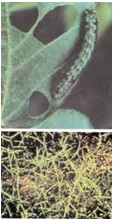
|
- The larvae feed on the foliage particularly on
young leaves and buds and cause heavy damage to
the foliage. During daytime they hide under clods
at the base of the plants and start climbing the
plants after dusk and feed at night. When food
becomes scarce, the caterpillars migrate in large
number in search of food plants.
|
Biology
- Eggs are deposited in mass on groundnut foliage and
are covered with fine grey hair of the female's body.
Most eggs hatch in 4 days, young caterpillars are whitish-green,
slightly translucent and inhabit terminal bud of groundnut.
They feed on the surface of leaves and skeletonize them.
- Larvae pass through 6 instarts in about 3 weeks. At
maturity the caterpillars enter the soil and pupate, usually
at 1-3 inches depth.
- The adults emerge after about 10 days. The female moth
produces sex pheromone that attracts males.
- This is a polyphagous insect and has been reported to
feed on groundnut, castor, brinjal, tobacco, tomato, maize,
agathi, jute, indigo, lucerne, cabbage, elephant yam,
peas, banana leaves, blackgram, greengram, cowpea and
grass. It also feeds on pods of chilli and pepper.
ETL
- The ETL for the pest in 8 egg masses/100 m of crop length
or 10% leaf damage.
Management
- Set up light trap or pheromone trap @ 5/acre
- Grow castor along the border and irrigation channels
as an indicator or trap crop.
- Collect the egg masses and destroy.
- Collect the gregarious early instar larvae in clusters
(which manifest the lace-like leaves by their feeding)
on castor, cowpea and groundnut and destroy them.
- Avoid migration of larvae by digging a trench 30 cm
deep and 25 cm wide with perpendicular sides around the
infested fields.
- Prepare a bait with the following materials to cover
one hectare. Rice bran 12.5 kg, molasses or brown sugar
2.5 kg and carbaryl 50 WP 1.25 kg. Mix the ingredients
to obtain a homogeneous mixture, sprinkle water gradually
and bring the bait to a dough consistency. Distribute
the above bait on the soil, around the field and inside
in the evening hours immediately after preparation.
- Application of nuclear polyhedrosis virus (NPV) @ 250
LE/ha with crude sugar 2.5 kg/ha in the evening hours
is as effective as that of insecticide spray.
- Apply any one of the following insecticides to control
early instar (Ist to 3rd instar) larvae.
1.Carbaryl 10 D-25 kg/ha;
2.Carbaryl 50WP 2.0 kg/ha;
3.Quinalphos 20 EC - 750 ml/ha;
4.Dichlorvos 76 WSC – 750 ml/ha;
5.Endosulfan 35 EC - 1.0 l/ha.
- Spray any one of the following insecticides per ha to
control 4th to 6th instar larvae.
1.Chlorpyriphos 20 EC - 2.0 lit;
2.Dichlorovos 76 WSC 1.0 lit;
3.Phenthoate 50 EC - 2.0 lit.
- Profenophos 0.1 percent of Neem oil 2 percent is recommended
for adoption to manage Spodoptera in groundnut by RRS
vridhachalam & ORS Tindivanam.
 Top
Top
White grub
Introduction
- White grubs, Holotrichia spp. are serious pests
in northern states and in Tamil Nadu these are serious
pests in localized areas of Cuddalore and Villupuram districts.
Stage and symptoms
|
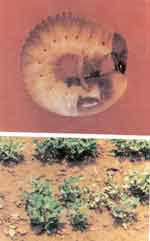
|
- The young grubs feed on rootlets and nodules,
the older grubs in third instar devour the entire
tap root and such plants wither and die. The maximum
damage occurs during August and September. The
damage usually occurs in patches in field and
the crop nearer to the hosts of adult beetles
suffers heavy damage.
|
Biology
- Both grubs and beetles are polyphagous but the later
are not regarded as major pests of field crops. The eggs
laid by the adult beetle start hatching after the first
summer rains.
- Eggs are laid singly in soil at a depth of 5-20 cm but
mostly at 5-8 cm. They are pearly white, oval and 2-2.5
mm long. The eggs hatch in 9-11 days.
- The just hatched larvae are translucent white and 3-5
mm long. With the access of suitable crop plants young
larvae begin to feed on rootlets and make rapid growth.
* Pupation takes place in soil from the end of September
to middle of October at a depth of 0.3 to 1.5 mm.
- The adults remain in soil until the ensuing monsoon.
Beetles emerge from soil shortly after the heavy pre-monsoon
or monsoon showers.
Management
- Summer ploughing helps to collect and destroy the larvae
and pupae of the pest.
- Early sowing may be useful in escaping from grub damage.
- Setting up light trap especially during May and June
months (a day after the first summer rains) to monitor
and collect the adult beetles.
- Collect adult beetles of white grubs attracted to trees
like neem, Acacia on receipt of monsoon shower
and destroy them.
- Branches of neem, tamarind and Acacia trees,
around the field may be pruned and sprayed with chlorpyriphos
@ 3 ml/lit of water.
- Hand pick the adults resting in the soil during day
time and destroy.
- ntomogenous fungi, Metarhizium anisopliae
and Beauveria brongniartii application @ 12.5 kg/ha
after mixing it with FYM and applied in furrows.
- Soil application of phorate granules @ 25 kg /ha at
the time of last ploughing.
- Seed treatment with chlorpyriphos @ 5 ml/kg of seed
- Dissolve 4.0 lit of chlorpyriphos /ha in irrigation
water while irrigating the crop.
- Place insecticides treated twigs of neem or Acacia
around the ground crop field to attract and kill the adult
beetles.
 Top
Top
Minor pests
Red spider mite
|
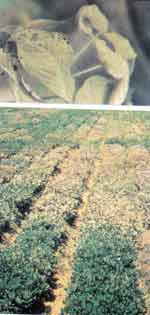
|
- This is a minor pest of groundnut in India. The
damage caused by the mite, Tetranychus
sp. is severe in crops are that under drought
stress, when complete drying of foliage can occur.
- The mite-infested leaves show stippling followed
by yellowing and finally turn almost white. Such
plants show extensive webbing and tips of the
plants may appear reddish because of the assembly
of large number of mites on them. Ultimately the
whole plant withers and die. The infestation spreads
slowly to the unaffected crop through and wind.
- Spraying of kelthane or dicofol (750 ml/ha)
was found effective.
|
Termites
|
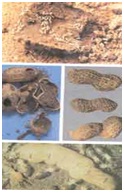
|
- A total of 18 species of termites infest groundnut,
of which the important one belongs to the genus
Odontotermes.
- Mud galleries of termites are seen on infected
plants. Pods damage by termite increases considerably
when there is a delay in harvesting.
- Termites penetrate and hollow out tap root and
cause wilting and premature death of plant. It also
feeds on pod shell and scarifies the pod externally
and occasionally bores into them, which render them
more susceptible to invasion by soil fungi, that
can attack seeds. Usually such seeds rot.
- Seeds from the pods damaged by termite contain
more aflatoxins than seeds from undamaged pods.
- Apply malathion 5 % D or lindane 5 % D @ 25 kg
/ha at the time of last plough.
|
Groundnut root borer [Sphenoptera perotetti
(Guer.)]
- It is important in some localized areas of Cuddalore
and Villupuram districts.
- The larvae bore the basal portion of the stem just beneath
the soil surface and tunnel through the main root resulting
in death of the plant. Such plants can be easily pulled
out from soil.
- The eggs are laid on the main stem of plant. The grubs
on hatching bore into stem. A fully-grown grub measures
about 3.5 cm in length. Grubs pupate in the larval burrow,
the pupal period is completed in 10 days.
- The maximum incidence of the insect was recorded in
October in kharif and April in summer.
- Cowpea, agathi, sickle senna and wild sunnhemp have
been reported to be the host.
- Soil application of malathion 5 % D @ 25 kg /ha before
sowing controls the pest.
Gray weevils
- Gray (or ash) weevils (Myllocerus spp) eat groundnut
foliage particularly during the rainy season, notching
or scalloping the edges of leaves. They are generally
of minor importance, but may pose problems in special
situations like hybridization blocks because they are
feed on flowers.
- To control this weevil, apply 25 kg/ha of malathion
dust early in the morning.
 Top Top
|
